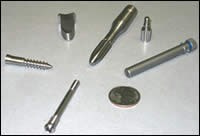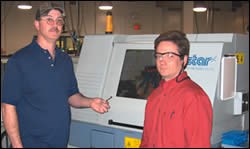Software Enables Transition To Medical Machining
When this company became a supplier to the orthopedics industry, in order to make the transition into medical machining, it began using PartMaker CAD/CAM software from PartMaker Inc. (Fort Washington, Pennsylvania) to program its CNC machines. The software has not only sped up programming but has also reduced setup time on Bell-Memphis’ machines.
The company started out as a contract manufacturer in 1942 for the World War II war effort. Bell-Memphis, Inc. (Memphis, Tennessee) then went on to develop a better design for turnbuckles in the 1950s, simplifying aircraft control cable repair and maintenance, and most recently became a supplier to the orthopedics industry. To make this transition into medical machining, the company uses PartMaker CAD/CAM software from PartMaker Inc. (Fort Washington, Pennsylvania) to program its CNC machines. The software has not only sped up programming but has also reduced setup time on Bell-Memphis’ machines.
Bell-Memphis first implemented PartMaker software in 2003 and now does virtually all of its programming with the software, according to Bob Latham, plant manager.
Featured Content
“Setup was the big issue. In a lot of cases, the software has reduced machine setup time by about 50 percent,” Mr. Latham says. “Less time is being spent at the machine proving out the program.”
Traditionally a screw machine shop, Bell-Memphis entered the CNC era in 1997 when the newly hired Mr. Latham convinced owners that the company had to modernize its manufacturing. Today, almost 10 years later, the company has more than 20 pieces of modern CNC equipment ranging from a variety of Star CNC Swiss-type lathes to a number of different types of mills, lathes and wire EDM machines.
“The move to medical for us was a very dramatic change,” Mr. Latham says. “If you would have walked in here in 1997, you would have seen your typical old, dirty manual shop with chucker and cam machines. We’ve done almost a total transition from that.”
Part of the transition has not only involved purchasing new machines, but investing in reliable, efficient software that PartMaker CAD/CAM has supplied for the company. The software is a CAD/CAM suite designed for programming a range of CNC applications, including CNC mills, lathes, wire EDM, turn-mill centers with live tooling and CNC Swiss-type lathes. This makes the software well suited for Bell-Memphis’ line-up of CNC equipment.
“The software has positioned us to facilitate the engineering process much better versus tying up the machine for an extended period of time on the programming side,” Mr. Latham explains. “With the software, you can develop the whole process from scratch and actually see what the part is going to come out looking like. The opportunity to pull in solid models and program off of them and then ultimately program the part is very helpful.”
PartMaker features an easy-to-use approach to programming and a common user interface, which, according to the manufacturer, makes it easy for a programmer to program a part for any type of CNC machine.
Because of the software’s capabilities and benefits, it has become an application that Bell-Memphis has grown to depend on and is not simply a luxury for the company. “I couldn’t do my job without it,” says Joe Eldred, CNC programmer. “The geometries of our parts are very complex.”
One of the software modules used by Bell-Memphis is SwissCAM, designed specifically for the complex programming requirements of CNC Swiss-type lathes. One of the technologies the program relies on for simplifying the programming of these machines deals with automating the programming of process synchronization for Swiss machines, a capability Mr. Latham, for one, appreciates.
“The biggest bottleneck in programming a Swiss machine is balancing out the wait codes. For me, that was a major nuisance prior to purchasing PartMaker. You can spend a day straightening out wait codes and getting all your synchronization right,” he says.
The company’s latest technologies, including PartMaker software, have allowed Bell-Memphis to focus on aerospace as well as medical manufacturing. In aerospace, the company manufactures its own line of turnbuckles for aircraft, while the medical side of the business strictly focuses on orthopedics manufacturing. Mr. Latham estimates that about 60 percent of his business is aerospace-related, with orthopedics making up the remaining 40 percent.
He sites the software as having been very beneficial in facilitating Bell-Memphis’ entry and success in medical manufacturing, where much of the work is complex and short-run because it is related to prototyping.
“Prototypes are how you cut your teeth in the orthopedics business. Most companies start out with that. You hope that when you produce the prototypes, you have the best opportunity at the production work,” Mr. Latham explains.
“The impact of PartMaker has been pretty dramatic, especially when we got into orthopedic parts that we wouldn’t have been able to make without the software. Looking at our Swiss machine, we had to do a lot of polar milling. From our standpoint, we wouldn’t have been able to do the job without the software. For us to try to program some of our orthopedic parts manually, it would have been a nightmare to get some of the geometry correct.”
RELATED CONTENT
-
From Setup to Final Pass: CNC Tool Management
With today’s high-powered and graphic-intense CNC, operators have everything under control, all on one screen.
-
What Is Trochoidal Turning? How Might Shops Benefit From It?
While trochoidal milling might be a more well-known toolpath strategy, trochoidal turning can offer similar benefits such as high material removal rates especially for rough-turning operations.
-
Consider the Software Side of Cutting Tools
The intersection of the cutting tool and the workpiece it is applied to represents the very heart of subtractive metalworking. There is a significant amount of technology behind getting the cutting tool into the right place, at the right speed and the correct depth of cut. This article looks at some of the software technology that can optimize the performance of the cutting tool.










